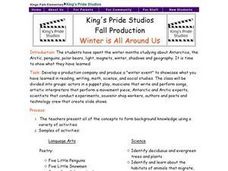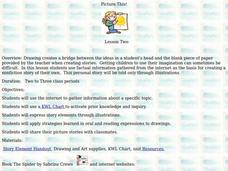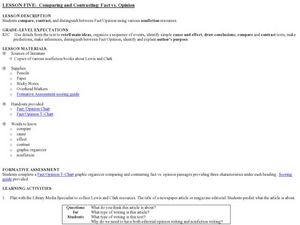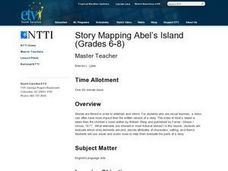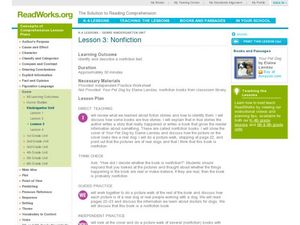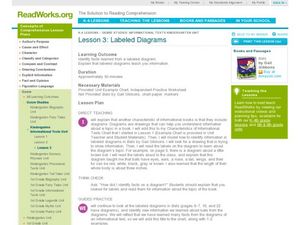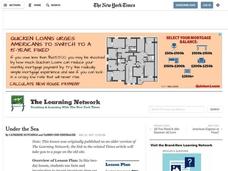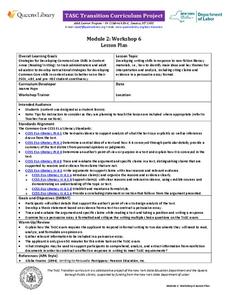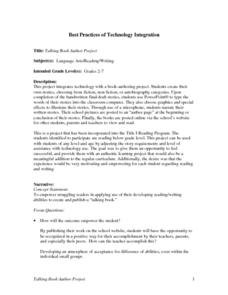Curated OER
Winter is All Around Us
Students present what they have learned on Antartica. Students identify deciduous and evergreen trees and plants; identify and study about the habitats of animals that migrate, hibernate, and adapt; study the Aurora and Aurora Borealis...
Curated OER
Picture This
Students explore finding facts from the Internet to create a nonfiction story. In this writing lesson, students fill out KWL charts and do internet research about the given topic of spiders. Students then create and illustrate...
Curated OER
Comparing and Contrasting: Fact vs. Opinion
Elementary schoolers investigate nonfiction stories by analyzing facts and opinions. They read nonfiction stories about the Lewis and Clark expedition. Pupils utilize a T-chart to list the facts and opinions on opposite sides, and then...
Curated OER
Using Non-Text Features
Second graders examine graphs and charts from their local newspaper. As a class, they discuss what the data means and how it relates to the article. In groups, they are shown two sets of graphs or charts and they practice explaining...
Curated OER
Story Mapping Abel's Island
Students are able to prioritize story elements using graphic organizers. They are able to evaluate character, setting and sequence in a non-print source. Students use visual and audio clues to help them evaluate the parts of a story.
Curated OER
Lesson 3: Nonfiction
Introduce young readers to the word of non-fiction. They examine the features found in non-fiction books such as, facts, dates, and realistic pictures. They discuss how the images in the book Your Pet Dog depict real dogs...
Curated OER
Under the Sea
Students identify and interpret that non-fiction books have features like a table of contents, a glossary, and an index, which can efficiently help them find information. They also identify how to narrow the search for information by...
Curated OER
Suspension Bridges: Connecting Lives
Students explore bridges. In this bridge lesson, students design and build a suspension bridge after visiting related websites and reviewing famous bridges in non-fiction books. Students follow the instructions from the...
Curated OER
Sequencing
Students consider how cause and effect translate into sequencing in literary works. In this sequencing lesson, students read non-fiction passages about Eleanor Roosevelt and Clara Barton. Students complete graphic organizers based on...
Curated OER
Lesson 2: Important Person
What kid wouldn't love to learn about George Washington? The class reads a simplistic biography about George Washington to find out why he is so famous. They chart the things he did, as well as what makes a non-fiction book a biography....
Curated OER
Labeled Diagrams
Let's learn about bats! Those flying creatures of the night inspire a instructional activity about non-fiction books. They start by charting characteristics commonly found in informational texts, specifically charts, diagrams, and...
Curated OER
Using Pictures to Support the Main Idea
Second graders practice using photos to support the main idea. In this reading comprehension activity, 2nd graders read and explore the photos in the book, Amazing Tigers! Students examine the photos to identify and support the main...
Curated OER
Lesson 1: Identifying Information in Nonfiction
If you are in need of a lesson on identifying information in a non-fiction text, look no further. The class learns how to use a KWL chart to identify explicit information in the book, Frogs by Gail Gibbons. They fill out the KWL...
Curated OER
Creating and Outline From Research
Fourth graders develop 3 research questions about a topic they choose and categorize the information they have learned. In this research lesson plan, 4th graders use a variety of non fiction materials from the library.
Curated OER
Animal Smarts Question Report
In this 10 question multiple choice worksheet, students choose the correct answer based on reading Animal Smarts. They read the non-fiction piece before determine the correct answers to the questions.
Curated OER
Under the Sea
Young scholars imagine and describe fictitious sea animals that might live in the ocean. After reading an article, they reflect on new discoveries found in the ocean recently. Using the internet, they research the interdependence of...
Curated OER
Mosaic America on Film: Fact Versus Fiction
Seventh graders define race, ethnic group, and culture. They identify the ways in which words are used in political cartoons and examine the way visual elements in a cartoon determine the meaning of words and enhance their impact. They...
Curated OER
Coming of Age Readings: Experiences in Korea and by Asians in America
Bring multi-cultural experiences and literature into your language arts class with this lesson. Here, young readers explore the points of view of first and second-generation Asian immigrants with a list of various fiction and nonfiction...
EngageNY
TASC Transition Curriculum: Workshop 6
Is a college education necessary for success in today's world? The class investigates the question, along with others at the end of the sixth workshop in a 15-part series. The instructional activity has four parts with multiple...
Curated OER
Evaluating Information Quality
Students evaluate information they are given and identify the quality of the information as fact, fiction, and point of view. In this information quality lesson plan, students also discuss how they can pick out good information verses...
Curated OER
Lesson 1:Using Headings to Determine the Main Idea (nonfiction)
Sometimes all you need is a good heading to determine the main idea in a block of text. Young readers learn how to use headings to guild them to determining the main idea. They practice as a class, in pairs, and then on their own. The...
Curated OER
Different Genres In Literature
Third graders view different genres of literature and identify which genre is being presented to them. In this genres lesson plan, 3rd graders choose from fiction, non fiction, and a poem.
Curated OER
Talking Book Author Project
Students explore fiction, non-fiction, and autobiographies. They create their own stories using one of the categories. Students create a PowerPoint presentation to tell their story.
Curated OER
How-To Books
Students apply their knowledge and create a how-to book of their own. In this early childhood language arts worksheet, students learn about non-fiction books and write their own procedural non-fiction booklets.
Other popular searches
- Non Fiction
- Non Fiction Text Features
- Non Fiction
- Non Fiction Writing
- Non Fiction Reading Passages
- Non Fiction Text
- Non Fiction Reading
- Non Fiction Reading
- Non Fiction Text Features
- Creative Non Fiction
- Elements of Non Fiction
- Non Fiction Graphic Organizer
